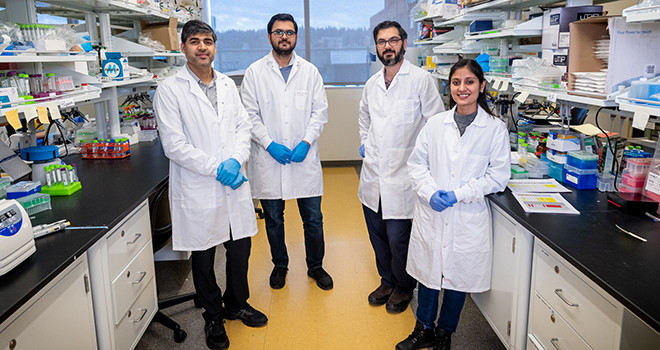WSU scientists ensuring drug safety in underrepresented populations
Wednesday, January 25, 2023

Washington State University scientists are helping to develop safer drug dosing standards for children and other populations that are underrepresented in clinical drug trials, such as pregnant women, older adults taking multiple medications, and people from certain ethnic groups.
Bhagwat Prasad, an associate professor in the College of Pharmacy and Pharmaceutical Sciences, is leading the research, which could help pharmaceutical companies and medical professionals determine the right dosing for many drugs prescribed to children that have only ever been tested in adults.
Since a child’s body handles drugs differently than an adult’s, it can be challenging to determine the optimal dose—enough to successfully treat the child’s condition, but not so much that the drug becomes toxic to the body.
“Some people are sensitive and can experience toxicity from a certain dose, whereas for others that same dose might not have any effect at all, not even a treatment effect,” said Prasad, who is an expert in the field of pharmacokinetics, the study of how the body absorbs, distributes, metabolizes, and eliminates drugs. “Children’s ability to eliminate drugs is very poor. So even when you use established methods for scaling down adult dosing, some children can still experience toxicity.”
Prasad and his research team study inter-individual variability in the activity of digestive enzymes that play a role in drug response. They use advanced analytical techniques to quantify enzyme activity in hundreds of samples of liver, kidney, intestinal, or other digestive organ tissues. Data from these studies then feed into mathematical models that can help predict dose safety in different populations for drugs that are metabolized by these enzymes.
“Using these methods, we can better understand this variability and predict its impact on dosing without the need to do clinical testing,” Prasad said. “This could potentially lower drug development costs, as well as save lives by eliminating unnecessary risks.” He said their work also contributes to the safer design of clinical trials for new candidate drugs.
With funding from the National Institutes of Health, Prasad and his research team are developing a mathematical model to predict how children will respond to drugs, along with methods to measure enzyme levels in blood or urine that could help determine the right dosing for children.
One example of the impact of Prasad’s work is a paper published in 2018 on UGT2B17, a little-studied enzyme that plays a role in metabolizing certain drugs. As part of that study, the researchers discovered that the enzyme is not present in children under the age of 9. They also found that one in four Caucasians and about 90% of Japanese people do not have the gene for UGT2B17 and that women have threefold lower levels of the enzyme than men.
Based on those findings, drugs that are metabolized by UGT2B17 are likely to present an increased risk of toxicity in children, women, Japanese people, and at least some Caucasians, Prasad said.
“We have recommended that pharmaceutical companies and the Federal Drug Administration consider this as they develop and evaluate new drugs.” he said. This could be done through precision clinical trials that measure participants’ UGT2B17 levels to finetune the dose given. In collaboration with the National Institutes of Health, University of Washington, and University of California Los Angeles, Prasad and his team are developing such a trial for a new male contraceptive pill after conducting a study that found that UGT2B17 was the primary cause of variable responses to the new investigational contraceptive. Prasad said that in other cases it may be possible to change the chemical structure of a drug so that it is not metabolized by UGT2B17.
The researchers’ findings are also cause for reexamining existing drugs that are metabolized by the enzyme. One such drug is a commonly used painkiller available by prescription only after reports linking it to heart toxicity led to it being pulled from U.S. drugstore shelves about a decade ago. Coincidentally, the risk of heart toxicity was found to be much higher in women, which Prasad said may be explained by his own finding that women have lower levels of UGT2B17.
“There’s a lack of understanding that people’s ability to handle drugs may vary,” Prasad said. “And that’s a big problem, because sometimes the side effects are more long term and so you don’t see them immediately.”
He said their modeling work could help predict such toxicity before it appears.
“The Food and Drug Administration is already recommending such mathematical models for safer clinical trials in children,” Prasad said. “The future of these models is that pharmacists or doctors will someday be able to use them to predict the right dose for the right patient to maximize a drug’s efficacy while minimizing harmful side effects.”